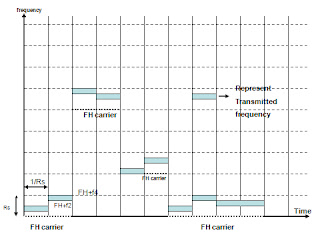Spread spectrum modulation
Definition:
"Spread spectrum modulation is a technique in which a communication signal is transmitted on a bandwidth considerably larger than the frequency content of the original information. Frequency hopping is a basic modulation technique used in spread spectrum signal transmission".
 |
Spread spectrum modulation
S S Mdulation Techniques
 |
S S Mdulation Techniques |
Applications of spread spectrum modulation
 |
| Applications of DS-SS system |
FH-MFSK receiver:
 |
| FH-MFSK receiver |
 |
Frequency hop spread M-ary FSK transmitter |

DSSS Coherent Binary Phase-Shift Keying Receiver


Frequency hop spread M-ary FSK transmitter

Magnified waveform for the period of 1st cycle

PSEUDO-NOISE (P-N) sequences
+sequences.bmp)
Spread spectrum signal m(t)=b(t).c(t)


maximum length sequence generator

- model of spread spectrum digital communication system


waveform of DS-SS transmitter

DSSS Coherent Binary Phase-Shift Keying Transmitter

